Journal of
eISSN: 2376-0060


Review Article Volume 11 Issue 2
1Surgery Assistant Surgical Academic Unit, Uruguay
2Thoracic surgeon HCFF.AA, Uruguay
3Former Assistant Professor- Emergency Department of the Hospital de Clínicas, Uruguay
4Resident of General Surgery Emergency, Department- Hospital de Clínicas, Uruguay
5Assistant Professor- Emergency, Department- Hospital de Clínicas, Uruguay
6Associate Professor- Thorax Surgery, Hospital de Clínicas, Uruguay
7Former Professor- Emergency Department- Hospital de Clínicas, Uruguay
Correspondence: Ulises Parada, Assistant Professor, Academic Surgical Unit “A” Hospital de Clínicas, Montevideo, Uruguay
Received: June 10, 2024 | Published: June 27, 2024
Citation: Parada U, Toscano L, Bado J, et al. Video assisted thoracoscopic surgery (VATS) in trauma: role of the emergency surgeon and surgical techniquenarrative review. J Lung Pulm Respir Res. 2024;11(2):55-60. DOI: 10.15406/japlr.2024.11.00319
Trauma consultations are frequent at the emergency departments of hospital centers. Emergency physicians and general or trauma surgeons are the first to provide assistance in the hospital setting. Making an accurate diagnosis and timely and appropriate treatment is the basis for saving patients' lives and reducing the incidence of complications. This is why we think that the general surgeon must have in his diagnostic and therapeutic arsenal the expertise to perform Video Assisted Thoracoscopic Surgery (VATS), which has its own indication that aims at safe and quality care.
The objective is to establish the scope of VATS, review the indications for the procedure, and provide practical steps for the implementation of the technique by general surgeons.
Keywords: chest trauma, VATS, trauma surgeon
VATS, video assisted thoracoscopic surgery; FBC, fibro bronchoscope
Trauma is the fourth leading cause of death in countries like the United States.1 Chest trauma maintains a high incidence and undoubtedly constitutes a challenge for the emergency surgeon who provides care. To this we must add that it can be accompanied by other injuries that make the situation even more complex. It is primarily responsible for 25% of trauma deaths and contributes significantly to another 25 to 50%.2
In Uruguay there are no national epidemiological data, however there are center references that can give an approximate perspective. In a metropolitan acute hospital where severe trauma patients were assessed, 46% of these are related to traffic accidents, mainly involving young patients, and have a mortality rate of close to 20%.3 This epidemiological profile is close to that of developed countries.
In another center where patients with occupational trauma are evaluated in Montevideo, a clear predominance of blunt trauma was recorded in 96% of the cases and the predominant lesion topography was the thorax in 70%.4
In a Mutual intensive care unit in Montevideo, it is recorded that 94% of thoracic traumas were closed, and 6% were open. The most common etiology of thoracic trauma was traffic accidents, reaching figures close to 73%.5
The injuries produced in the thorax cover both the continent: muscle masses, rib cage and sternum, with their own implications due to their repercussions on ventilation; and the content: heart, great vessels, trachea, bronchi and lungs that record the highest morbidity and mortality from chest trauma.
The evaluation of these patients begins in the emergency department, therefore it is the trauma surgeon or general surgeon who must be trained to make the diagnosis, provide appropriate treatment and avoid complications.
The majority of these injuries are managed conservatively with analgesia, physiotherapy and oxygen, such as rib fractures and small lung contusions.6
Pneumothorax and hemothorax are managed with pleural drainage in the vast majority of cases. The guidelines establish that an initial flow rate of 1500 cc or a sustained flow rate of 200-400 cc hour for 2 to 4 hours is an indication for thoracotomy.7
However, there are intermediate situations in which a thoracotomy would seem to be a therapeutic excess and chest drainage, insufficient, leaving diagnostic and therapeutic uncertainty.
It is at this point where Video Assisted Thoracoscopic Surgery (VATS) takes precedence. Like other mini-invasive procedures such as laparoscopy and endovascular procedures, they seek to reduce surgical aggression and are associated with less morbidity and faster recovery compared to the open approach.8
VATS in the emergency is a diagnostic and therapeutic tool with precise indications. More than a therapeutic alternative to drainage or thoracotomy, it has specific recommendations that allow solving the problem, achieving a correct lesion balance and avoiding complications.
However, there seems to be a lack of scientific literature with a high level of evidence on the use of VATS in the emergency of thoracic trauma.9 Most refer to clinical cases or case series. The objectives of this work are: Establish the scope of VATS as a diagnostic and therapeutic tool in thoracic trauma, review the indications for the procedure, and provide practical technical steps for the implementation of the technique by general surgeons.
It is indicated only in stable patients. In the case of an unstable patient, the open approach is recommended for correct and faster control of bleeding.
The patient should be placed in a lateral decubitus position, leaving the affected hemithorax upward. This position is recommended by the author group since it allows a good visual field, exposing the continent and contents of the entire hemithorax. Due to this situation, it is important that the injury be limited to only one side of the thorax, since approaching the other hemithorax would mean a change in the patient's position and approach, with all that this implies.
This lateral decubitus position, typical of thoracic surgery, is not always possible in trauma. It can also be done with the patient in a supine position and a slight rotation of the corresponding hemithorax towards the contralateral side. Although this limits visualization and exposure, it allows, if necessary, a faster approach to the contralateral hemithorax.
Conditions and trained teams for both anesthesia and surgery are needed. Lung collapse of the affected hemithorax allows correct visualization of the cavity and therefore thorough surgical exploration. One-lung ventilation is achieved with double lumen tube and bronchial blockers (Figure 1). In the case that if the patient does not tolerate unilateral ventilation, two-lung ventilation with intermittent apneas can be considered as an alternative.
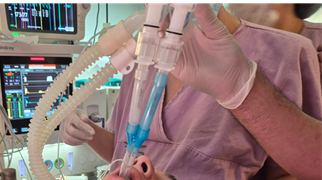
Figure 1 Selective orotracheal intubation. It allows lung collapse of the affected hemithorax and ventilation of the contralateral hemithorax. For correct management, it requires an anesthesiologist trained in the use of the Fibro bronchoscope (FBC).
VATS makes it possible to make a precise anatomolesional diagnosis and at the same time perform the definitive treatment of hemostasis and/or aerostasis, avoiding possible future complications such as retained hemothorax, persistent air fistula and empyema.
The use of VATS is proposed to manage the following situations:
Hemothorax is the main indication for surgery in chest trauma, which can reach up to 68% of cases (Figure 2).10
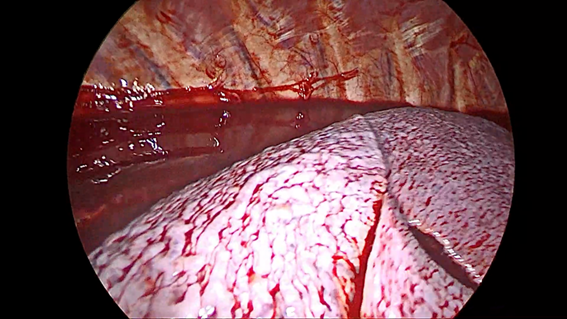
Figure 2 VATS in a patient with a gunshot wound. Hemothorax is observed with collapse of the lung parenchyma.
Placing a chest drain is often not enough to evacuate the blood contained in the pleural cavity, giving rise to complications such as retained hemothorax, which can then become infected or even form a thick fibrotic layer that leads to lung entrapment.
The objective of VATS is to evacuate the hemothorax, identify and stop the source of bleeding and carry out a correct injury balance. The author group considered that in these aspects, VATS achieves greater safety in care and avoids future complications with the advantages of the mini-invasive approach (Figure 3).
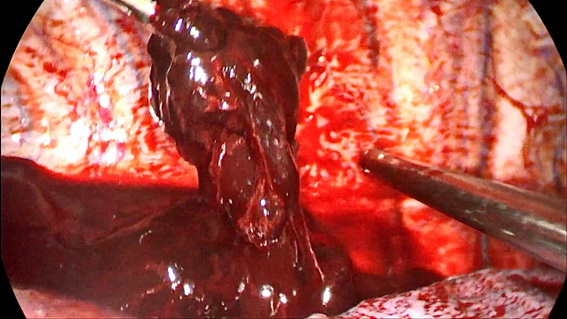
Figure 3 Retained hemothorax due to gunshot wound to the right hemithorax. You can now see an organized clot that makes evacuation difficult. The correct pleural toilet is achieved by fragmenting and aspirating the clot with a bimanual maneuver.
The hemorrhage may be stopped at the time of examination since it is usually due to small vessels and is subject to pressure from the right cavity (lung parenchyma). On other occasions, bleeding can be pulsatile under systemic pressure such as the intercostal pedicle. In these cases, identifying the bleeding point and performing hemostasis not only contributes to maintaining the patient's hemodynamics, but also avoids perpetuating the hemothorax and maintaining a correct toilet.
The delay in therapy can increase the risk of lung entrapment and bacterial superinfection. In Figure 3 we see organized hematoma, despite the few hours of evolution, its evacuation is difficult only with the placement of drainage due to the gelatinous and adherent consistency it presents.
In the context of traumatized patients, the search for associated injuries is not a minor issue. In this sense, direct inspection of the esophagus and diaphragm, whose lesions are particularly difficult to diagnose solely by imaging, gives added value to VATS.10
Currently there is evidence that VATS has advantages over chest drainage in the following aspects; decrease in infection 18 vs 47%, duration of ventilatory dependence 7 vs 14 days and hospital stay 19 vs 34 days, all statistically significant.11
Technically, clotted blood is difficult to evacuate with a 5 mm aspirator; fragmenting the clot with forceps or lysis with warm distilled water helps in evacuation. Other times, a Yankauer aspirator is placed, as its larger caliber makes it easier to aspirate. The way to perform hemostasis is variable: placement of clips, coagulation of vessels, use of biological glues, even wedge resection of lung parenchyma. (Figure 4).12
Traumatic pneumothorax alone or associated with a small hemothorax does not constitute an indication for VATS in an emergency. When they are lamellar or small and asymptomatic, they can be managed expectantly.13 Those of greater magnitude or poorly tolerated that require placement of a chest tube may present a persistent air leak of more than 3 or 5 days that may even prevent the complete lung reexpansion, these patients may benefit from VATS for aerostasis. However, when we perform VATS in the context of extraction of a foreign body under vision, or a hemothorax, and injury to the lung parenchyma with air leak is confirmed, the therapeutic objective is to perform aerostasis. Therapeutic options will depend on the size and topography of the lesion, as well as the degree of functional reserve.
Once the injury to the lung parenchyma is identified (Figure 5), it should be assessed for air leakage. To do this, warm distilled water is placed in the pleural space and the injured lung sector is submerged as shown in Figure 6. At that time, the anesthesiologist is asked to ventilate the lung in question. The test is considered positive when bubbles are produced during expansion.
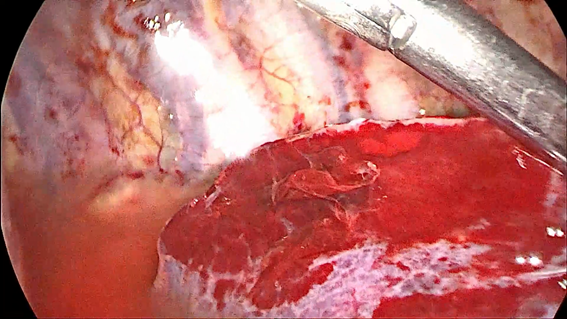
Figure 5 Lung parenchymal injury due to gunshot wound, a lesion of approximately 1-2 cm and parenchymal ecchymosis is visualized.
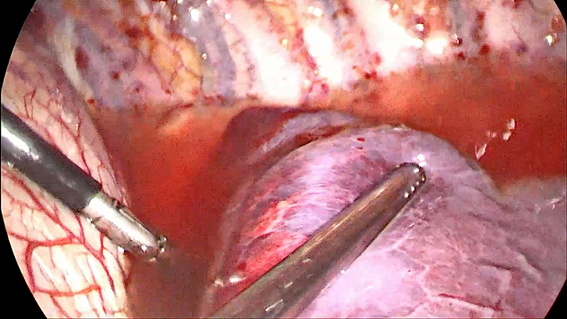
Figure 6 Hydropneumatic test. Placing the lung under distilled water and subsequent ventilation assessing whether there is air leak.
Lung parenchymal injuries are classified according to the mechanism of injury and associated findings. Superficial lacerations (type III) are most appropriate for surgical management with mechanical suturing. The objective is to stop bleeding and air leak, for which an atypical resection preserving the greatest amount of lung parenchyma is sufficient (Figure 7).15,16
VATS is an important diagnostic method for diaphragmatic injuries, with a sensitivity close to 100%; It also allows its repair. This approach provides good visualization of the diaphragmatic dome that can be improved by positioning the patient in the Trendelenburg position (Figure 8). Placing a nasogastric tube to degravitate the stomach facilitates reduction of any hernia. Generally in these cases the repair is performed with stitches of non-absorbable material.17,18
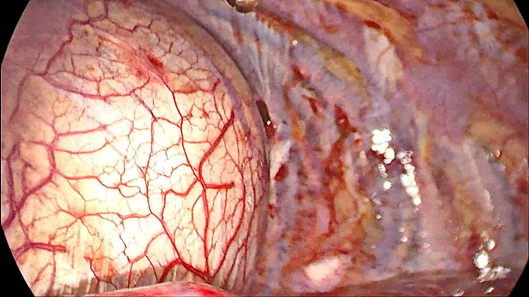
Figure 8 Visualization of the diaphragmatic dome. The patient is placed in the Trendelenburg position and the entire diaphragm is explored. VATS has 100% sensitivity for diagnosing injuries.
The advantage of VATS in the approach to diaphragmatic injuries lies in its high diagnostic sensitivity, the possibility of repairing especially small lacerations and without the risk of tension pneumothorax, as can occur in laparoscopic abdominal approaches when pneumo peritoneum is performed. The disadvantage is that it requires pleural drainage and repair from the thorax is usually difficult, especially when the continuity gap is large, which requires high technical demand and a trained surgeon.19
Its rapid diagnostic identification and therapeutic response are key to preventing mortality. Early surgical intervention, before 24 hours of injury, has a published mortality of around 13%; On the contrary, after this period of time, mortality reaches 55%.16
Esophageal injuries with conservative treatment (antibiotic therapy and nasogastric tube) almost always lead to therapeutic failure. The traditional approach requires suturing in 2 planes with an open approach (thoracotomy).20
In esophageal perforation, VATS, although there are cases reported with good results, still does not guarantee adequate access and drainage of the mediastinum. Therefore, thoracotomy continues to play a key role in the management of these patients.
The extraction of foreign bodies, regardless of the corresponding anatomical location, must be performed in the operating room in order to objectify the injuries that have occurred. Specifically, chest injuries due to a foreign body in stable patients can be extracted under direct vision by VATS in order to carry out lesion balance, perform treatment (aerostasis, hemostasis) with the advantages of the mini-invasive approach.21 Figure 9 shows a foreign body (prison cut) in the right hemithorax, mid-clavicular line, above the nipple. After the chest x-ray was performed, given the hemodynamic stability of the patient, the decision was made to extract the foreign body in surgical block by VATS (Figures 10 & 11).

Figure 10 Extraction under vision by VATS that allows correct lesion balance. In this case, to have a greater perspective of the injuries, the optical trocar was positioned behind the posterior axillary line (adaptive concept). On the other hand, you can reposition the optics in the rest of the trocars for a correct assessment of injuries and even add other access trocars (dynamic concept).
In the event that bleeding occurs after extraction that cannot be controlled by video surgery, a quick conversion to open surgery will be performed.
Hemodynamic instability, suspicion of cardiac or great vessel injury, is an absolute contraindication for VATS, since the open approach allows faster control of hemorrhage. The VATS pericardial window can be used in penetrating thoracic trauma, in hemodynamically stable patients, although if cardiac lesions are found, they are not susceptible to being resolved by a mini-approach.22
Patients with tracheobronchial injuries, given the challenge it poses for both surgeons and anesthesiologists, should not be considered candidates for VATS.
Relative contraindications are: previous thoracic surgery, radiological signs of pleural adhesions or pleurodesis and, in the context of a polytraumatized patient, difficulties in accessing the pleural cavity, as well as the impossibility of correct ventilation.23
As mentioned, the placement of a double lumen tube is required for selective pulmonary intubation that allows the collapse of the parenchyma. It is usual to use a left probe due to its ease of placement. Once placed, its position is confirmed with Fibro bronchoscopy by the anesthetist and fixed. Another alternative is endoluminal blockers.
The patient is placed in a lateral decubitus position contralateral to the hemithorax being approached. This maneuver will be coordinated by the anesthetist in order to avoid displacement of the tube in the airway. The leg resting on the operating table should be placed semi-flexed and the upper leg should be kept straight with a roll in the middle to improve support.
A roll is placed at the thoraco abdominal level that allows greater opening of the intercostal spaces. Two lateral rolls to the trunk and a tape at the height of the pelvis fixed to the operating table. The arms are placed in a prayer position.
The objective of video surgery in trauma is to perform a correct examination and not overlook any injury. To achieve this, the adaptive and dynamic concept of trocar placement is used. This requires suspicion of path and injured organs. The adaptive concept seeks to adjust to the type of trauma and site of entry of the injury in such a way as to carry out the injury balance with the best perspective (Figures 10 & 12). Furthermore, the term dynamic refers to the possibility of changing the optics to the different trocars placed in order to avoid leaving blind spots and overlooking damaged organs. Generally we will place 3 trocars, following principles of triangulation such as abdominal surgery with the exception that in thoracic surgery the placement of CO2 is not necessary since the thorax tends to expand and the lung parenchyma to collapse (selective intubation) leading to a cavity that facilitates visualization and surgical maneuvers. We will use 3 trocars: 2 of 10 mm and 1 of 5 mm without valve, which allow free circulation of air to avoid reexploding the lung during aspiration. The incision is made in the direction of the intercostal spaces and the space is opened with scissors, following the upper edge of the lower rib to avoid intercostal bundle injury.
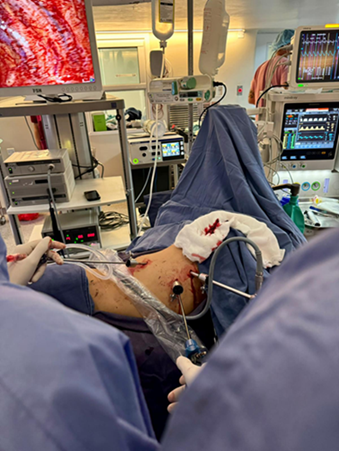
Figure 12 VATS in right thoracolumbar gunshot wound. Patient in left lateral decubitus position. Monitor is displayed behind the patient's back, optical trocar in the anterior axillary line, 4th intercostal space.
In an operational sense, a practical place for placing the first trocar is the 4th intercostal space, mid-axillary line. Placing it in this (high) position is to avoid injury to the diaphragmatic dome and/or abdominal contents (even favored by traumatic phrenic paralysis or herniation of abdominal contents into the thorax). The use of a 30° optic makes it possible to avoid blind spots and to ensure that no intrathoracic injury goes unnoticed.
If there is only one monitor, it will be placed behind the patient. And the surgeon on the ventral side of the patient, the first assistant towards the caudal side. Multimodal analgesia is important and in this regard intercostal nerve blockade with bupivacaine is essential to improve postoperative pain.
The surgery culminates with the placement of the pleural drain and lung expansion under vision, leaving a drainage tube under a water trap.
VATS is gaining followers in the care of trauma patients. It is a safe procedure in stable patients and with teams trained in the technique. It is a diagnostic and therapeutic tool and protects against possible complications, with the advantages of the mini-invasive approach. The general or trauma surgeon, who provides care in emergency centers, must consider that VATS, for the hemodynamically stable patient, is a fundamental tool that must be part of the diagnostic and therapeutic care arsenal.
VATS is a therapeutic option that has precise indications for thoracic trauma in emergencies. The correct selection of patients for VATS results in quality care, as well as patient well-being and safety.
None.
The authors declare that there are no conflicts of interest.

©2024 Parada, et al. This is an open access article distributed under the terms of the, which permits unrestricted use, distribution, and build upon your work non-commercially.